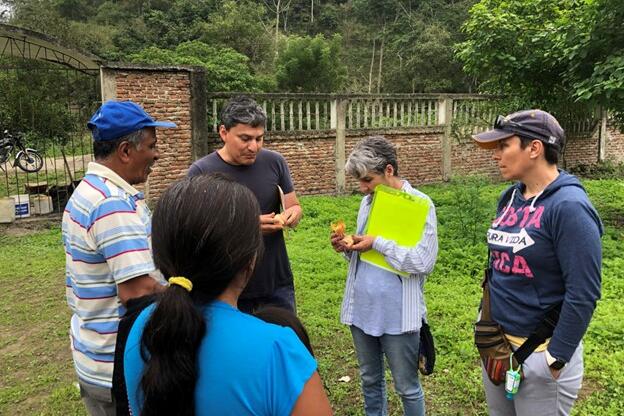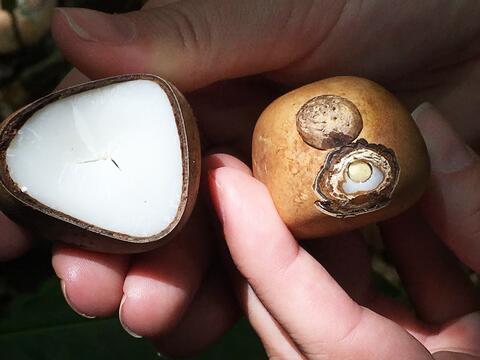How local communities depend on the ivory palm tree in coastal Ecuador

URBANA, Ill. – The ivory palm tree, also known as tagua, is endemic to the Chocó-Darien region on the Pacific coast of South America. The local population relies on this unique tree for many uses and the tagua fruit, nuts, and leaves provide materials for a range of products. Two studies from the University of Illinois Urbana-Champaign and Pontificia Universidad Católica del Ecuador (PUCE) explore the ecosystem services provided by tagua in coastal Ecuador.
The ivory palm is considered a threatened species as 98% of forest land in western Ecuador has been cleared, although current conservation practices often leave the tagua trees standing amidst agricultural land.
The tree’s large, characteristic fruit contains seeds that harden into a white material known as vegetable ivory, which is harvested and traded in the global marketplace.
“Since the start of the 20th century, companies have been utilizing the seed of this palm to produce buttons, and it is very popular in the global garment industry. The tagua trade had a strong impact on the local economy of western Ecuador in the first half of the 20th century,” said Rommel Montúfar, professor at PUCE and co-author on both papers.
The button export has slowed over the past decades, but there are efforts to develop other materials from tagua fruit and nuts.
“Some companies are trying to use powder from tagua nuts as ingredients in cosmetic products for skin exfoliation and other applications. There is a huge interest in tagua nanotechnology, as it can be used as a substitute for plastic or in medical applications,” Montúfar explained. “But the question is if there will be enough natural materials to support these initiatives. Our research provides input for conservation efforts.”
For the first study, the researchers conducted focus groups in three tagua harvesting communities in western Ecuador.
“As economists, we would assume the most important value has to be the export of the tagua buttons. But we wanted to go into the research without any assumptions and let the participants tell us what's important to them about this resource,” said Shadi Atallah, associate professor in the Department of Agricultural and Consumer Economics (ACE), part of the College of Agricultural, Consumer and Environmental Sciences (ACES) at U. of I. Atallah is corresponding author on the studies.
“We wanted to learn how the local population depends on tagua for their livelihood. We already had an idea about the economic impacts, but these communities use the palm for a lot of other purposes, which need to be brought to light if we're thinking about conservation,” explained co-author Jacob Gehrung, analyst with Resilient Buildings Group. He helped conduct the field research in Ecuador as an undergraduate student at the University of New Hampshire.
Based on the focus group discussions, the research team identified 28 ecosystem services, divided into four categories.
Provisioning services include practical purposes, such as material for buttons, artisanal crafts, and roof thatching, as well as human food and medicine. Regulating services include, for example, habitat conservation, pollinator attraction, and shade for humans and animals. Supporting services refer to the palm’s interaction with animals and other plants in the environment. Cultural services include the role of the tree in cultural identity, religious activities, and recreation.
While the button trade is the most frequently studied aspect of the tree, it wasn’t the main topic of the focus group discussions. Participants viewed it as too unstable and unpredictable because prices fluctuate with global demand and fashion trends.
The most frequently mentioned provisioning services were the use of leaves for thatching roofs, a traditional practice that is still used in some locations, followed by food and medicine. But overall, participants spoke more about cultural and supporting services than provisioning.

For the second study, the research team developed a survey to further explore and quantify the importance of different ecosystem services. They collected responses from 80 tagua harvesters in six communities, all with less than 200 inhabitants and a high poverty rate.
The harvesters rated their household’s livelihood dependence on 17 different tagua ecosystem services, derived from the focus group data. Respondents were asked to rate dependence from the point of view of their grandparents, parents, their own, and the future generation.
“Overall, people depend less on tagua today than their grandparents did. However, the earlier boom of the tagua trade affects how they feel about the future. They have expectations that at some point the trade will come back, and that it will play a bigger role for their children,” said Jorge Salgado, who is co-author on the second paper. Salgado taught economics at PUCE and is currently pursuing a doctoral degree at the University of Lausanne.
“These villages are some of the poorest in Ecuador. It’s important to understand how they feel about the different services that nature is providing them. Policymaking shouldn’t happen from the top down; it should be based on input from the communities,” he added.
The surveys showed some respondents are concerned their children are less culturally attached to tagua and the culture will erode.
“However, there is a correlation between what they expect is going to happen economically and culturally. This indicates that investing in the economics of tagua could also bring back the cultural attachment,” Atallah noted.
The research findings have implications for policymakers looking to implement sustainable harvesting practices and promote economic development.
“The local harvesters are not just thinking about money, they are also interested in cultural issues and the tree’s role in supporting plants and animals.” Atallah said. “Ecuador’s environmental authority seeks to determine what makes a sustainable harvest. However, it’s important to recognize that there is a bouquet of uses, not just the export business. Policymakers need to take these complementarities and trade-offs among ecosystem services into consideration, so they don’t over-emphasize one aspect at the detriment of the others.”
The first paper, “Identifying the Ecosystems Services of the Ivory Palm (Phytelephas aequatorialis Spruce): A Qualitative Study from the Central Coast of Ecuador,” is published in Economic Botany [doi.org/10.1007/s12231-022-09552-9]. Authors include Rommel Montúfar, Jacob Gehrung, Michael Ayala Ayala and Shady Atallah.
The second paper, “Intergenerational livelihood dependence on ecosystem services: A descriptive analysis of the ivory palm in coastal Ecuador,” is published in Agricultural and Resource Economics Review [doi.org/10.1017/age.2023.21]. Authors include Jorge Salgado, Rommel Montúfar, Jacob Gehrung, and Shady Atallah.
Support for the research was provided by Pontificia Universidad Católica del Ecuador, the Universidad Central del Ecuador, the International Joint Laboratory BIOINCA, and the University of New Hampshire’s Hamel Center for Undergraduate Research.
A photo album with tagua tree pictures is available through Box.